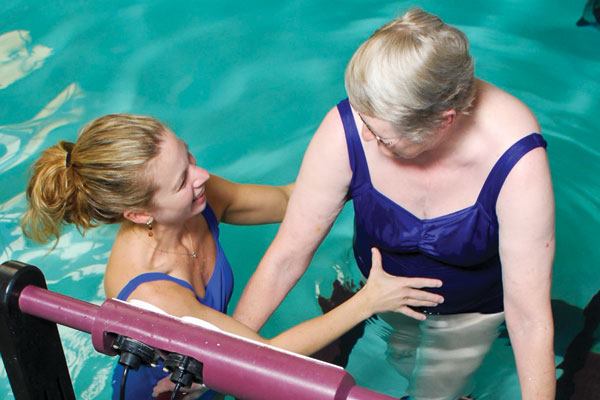The concept of aquatic therapy is as old as the earliest recorded history, making the last quarter century nothing but blink of an eye. But what a blink.
“What’s been surprising about the last 25 years is the explosive growth. It’s a brand-new industry and growing like crazy,” says Ruth Sova, who founded the Aquatic Therapy & Rehabilitation Institute in 1992 — a spinoff of the Aquatic Exercise Foundation. The institute provides training to physical therapists, water instructors and others who want to expand their knowledge of how to work with patients or clients in water.
In addition to increased general awareness of the benefits that water can bring to the body, much of the growth is due to baby boomers who want to continue exercising without sacrificing their joints.
The 1970s and early 1980s were a “dark age” for hydrotherapy, according to Bruce Becker, clinical professor in the department of rehabilitation medicine at the University of Washington and co-author of the book Comprehensive Aquatic Therapy (Butterworth-Heinemann, 2003) At that time, water was less used for treating ailments such as polio and arthritis than it had been previously, something Becker attributes to the development of the polio vaccine and cortisone.
“Hospitals started filling in their pools and, as a result, therapists stopped being trained,” he explains. “It was quite remarkable how it was not being used.”
ATRI sought to increase training when it began offering in 1999 an aquatic therapy practitioner certificate, which can be attained by therapists, water instructors or any knowledgeable lay persons who want to expand their expertise.
Just a few years earlier, in 1996, the Aquatic Resources Network had been founded by Andrea Salzman, with the goal of fostering appropriate use of aquatic therapy through communication, education, research and entrepreneurship. The network, which started with 30 members, now has a database of more than 10,000 aquatic therapy providers, facilities and vendors.
Another growth spurt came when some insurance providers began to recognize the benefits of aquatic physical therapy, Sova says. “The therapists who use water see incredible results, and insurance companies are paying for it,” she explains.
Pools also have become common tools for athletes competing at the highest levels. “I can’t think of a pro or college-level sports program that doesn’t use a pool for rehab,” Becker says.
As knowledge of the benefits of aquatic therapy has increased, so has the demand for new techniques.
While Bag Radaz and Halliwick are still practiced, numerous innovative methods also have emerged, including Ai Chi, PNF, Watsu, Feldenkrais, Burdenko, Ortho Aquatic Exercises, Aqua Yoga, Water Aerobics and BackHab.
The emergence of new techniques has, in turn, changed programming.
“The courses we have now are more specific and guided,” Sova says. “We used to offer walking in water or walking for orthopedic issues. Now our classes focus in on particular areas, for example, just the knees, the shoulders or the feet.”
While the field of aquatic physical therapy is not as large as aquatic fitness, the impacts of these disciplines has had a ripple effect felt in general aquatic fitness classes.
“There is a definite exchange of information and ideas between aquatic therapy and aquatic fitness,” says Julie See, director of education at the Aquatic Exercise Foundation, based in Nokomis, Fla. “The similarities are increasing as we are recognizing that health, wellness and fitness are a continuum.”
See adds that it’s not uncommon for a person who underwent surgery, for instance, to spend a month or six weeks in rehab, then to move on to attending water fitness classes.
Plus, more types of equipment are available to aquatics therapists today. While they may still use kickboards or noodles, other items get added to the mix, such as flotation devices, gloves, belts, paddles and dumbbells.
Finally, more pools today are equipped with features that can be used to address patients’ needs, document their progress or monitor where they require more attention.
“You can turn on jets in some pools, or there are ones with treadmills at the bottom,” Mitchell says. “Some of them have cameras so you can see how people move underwater.”
But despite the leaps and bounds made in this burgeoning field, there is still a need for new research and innovation. “There’s a lot of work yet to be done,” Becker says. “[For example, aquatic therapy] is still not accepted for congestive heart failure or management of anxiety and depression or post-traumatic stress disorder.”


